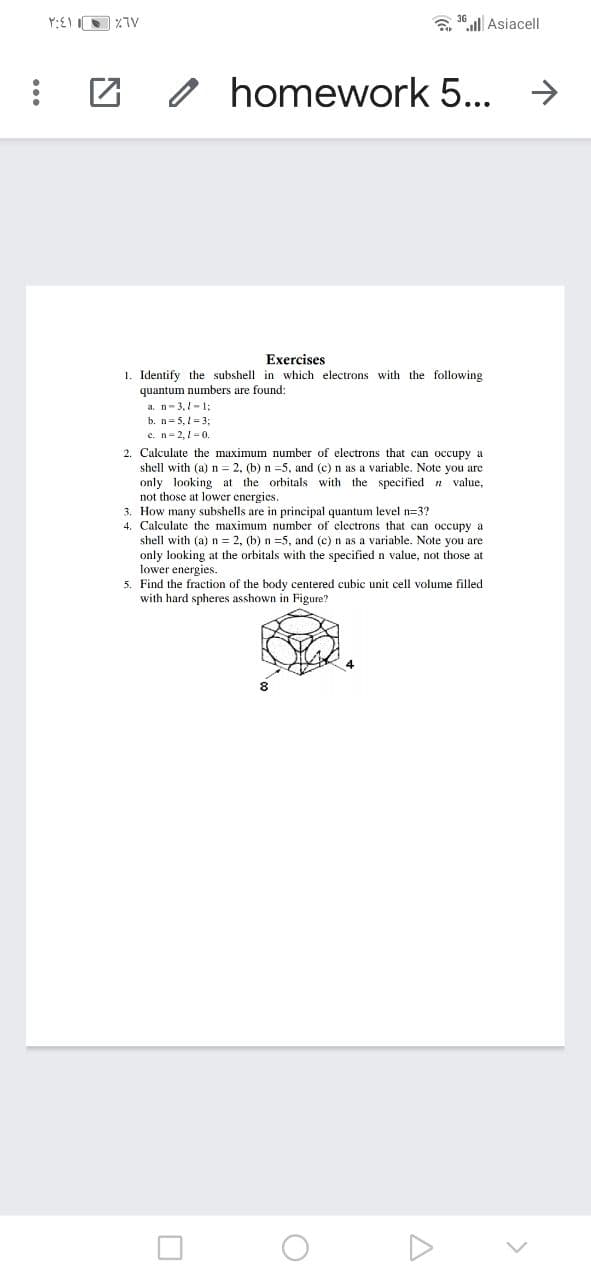1. Identify the subshell in which electrons with the following quantum numbers are found: an-3,1-1: b. n= 5,1=3; cn-2,1-0. 2. Calculate the maximum number of electrons that can occupy a shell with (a) n = 2, (b) n =5, and (c) n as a variable. Note you are only looking at the orbitals with the specified n value, not those at lower energies. 3. How many subshells are in principal quantum level n=3?
1. Identify the subshell in which electrons with the following quantum numbers are found: an-3,1-1: b. n= 5,1=3; cn-2,1-0. 2. Calculate the maximum number of electrons that can occupy a shell with (a) n = 2, (b) n =5, and (c) n as a variable. Note you are only looking at the orbitals with the specified n value, not those at lower energies. 3. How many subshells are in principal quantum level n=3?
College Physics
1st Edition
ISBN:9781938168000
Author:Paul Peter Urone, Roger Hinrichs
Publisher:Paul Peter Urone, Roger Hinrichs
Chapter29: Introduction To Quantum Physics
Section: Chapter Questions
Problem 82PE: Integrated Concepts A laser with a power output of 2.00 mW at a wavelength of 400 nm is projected...
Related questions
Question

Transcribed Image Text:Y:EI I
a 30 l| Asiacell
homework 5... →
Exercises
1. Identify the subshell in which electrons with the following
quantum numbers are found:
a. n- 3,1-1:
b. n= 5, 1 3;
e. n-2,1=0,
2. Calculate the maximum number of electrons that can occupy a
shell with (a) n = 2, (b) n =5, and (c) n as a variable. Note you are
only looking at the orbitals with the specified n value,
not those at lower energies.
3. How many subshells are in principal quantum level n=3?
4. Calculate the maximum number of electrons that can occupy a
shell with (a) n = 2, (b) n =5, and (c) n as a variable. Note you are
only looking at the orbitals with the specified n value, not those at
lower energies.
5. Find the fraction of the body centered cubic unit cell volume filled
with hard spheres asshown in Figure?
Expert Solution
This question has been solved!
Explore an expertly crafted, step-by-step solution for a thorough understanding of key concepts.
Step by step
Solved in 2 steps with 2 images

Knowledge Booster
Learn more about
Need a deep-dive on the concept behind this application? Look no further. Learn more about this topic, physics and related others by exploring similar questions and additional content below.Recommended textbooks for you

College Physics
Physics
ISBN:
9781938168000
Author:
Paul Peter Urone, Roger Hinrichs
Publisher:
OpenStax College


Modern Physics
Physics
ISBN:
9781111794378
Author:
Raymond A. Serway, Clement J. Moses, Curt A. Moyer
Publisher:
Cengage Learning

College Physics
Physics
ISBN:
9781938168000
Author:
Paul Peter Urone, Roger Hinrichs
Publisher:
OpenStax College


Modern Physics
Physics
ISBN:
9781111794378
Author:
Raymond A. Serway, Clement J. Moses, Curt A. Moyer
Publisher:
Cengage Learning

College Physics
Physics
ISBN:
9781285737027
Author:
Raymond A. Serway, Chris Vuille
Publisher:
Cengage Learning

Principles of Physics: A Calculus-Based Text
Physics
ISBN:
9781133104261
Author:
Raymond A. Serway, John W. Jewett
Publisher:
Cengage Learning

College Physics
Physics
ISBN:
9781305952300
Author:
Raymond A. Serway, Chris Vuille
Publisher:
Cengage Learning